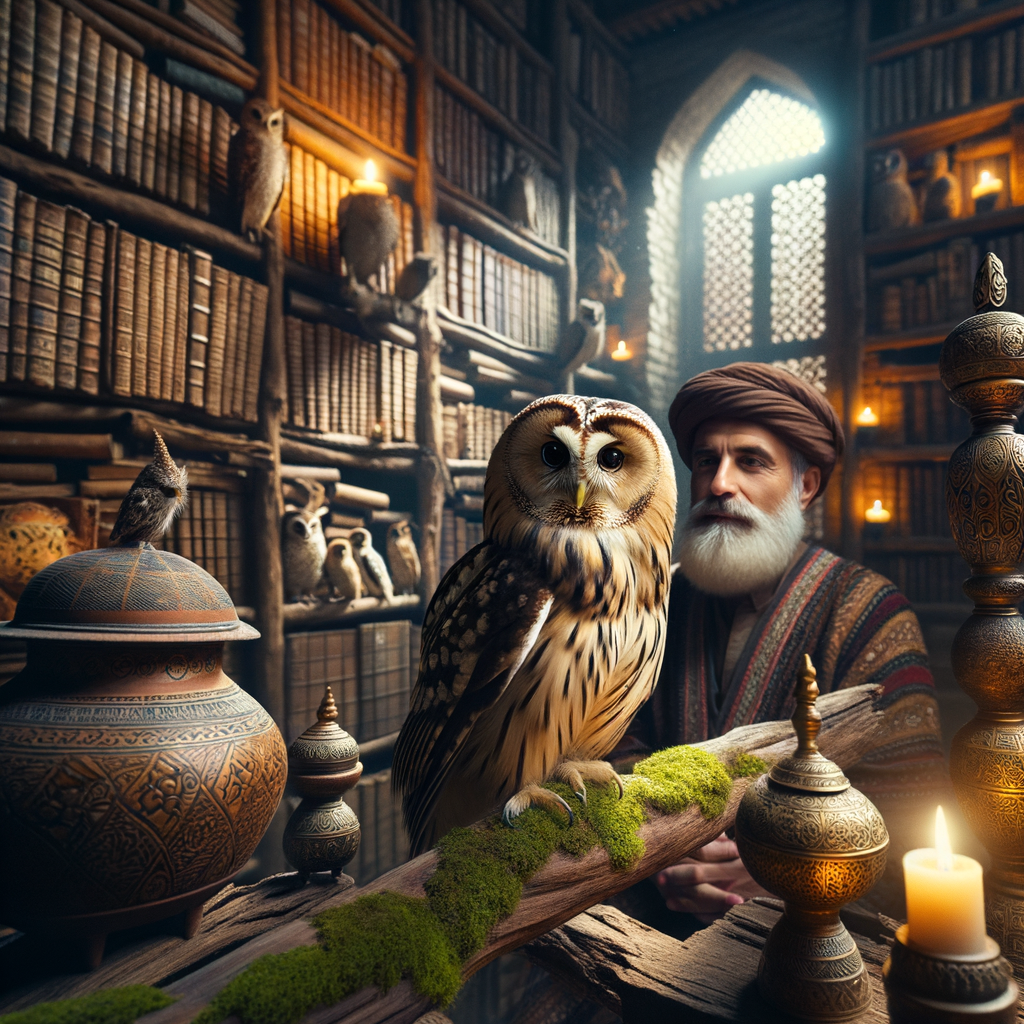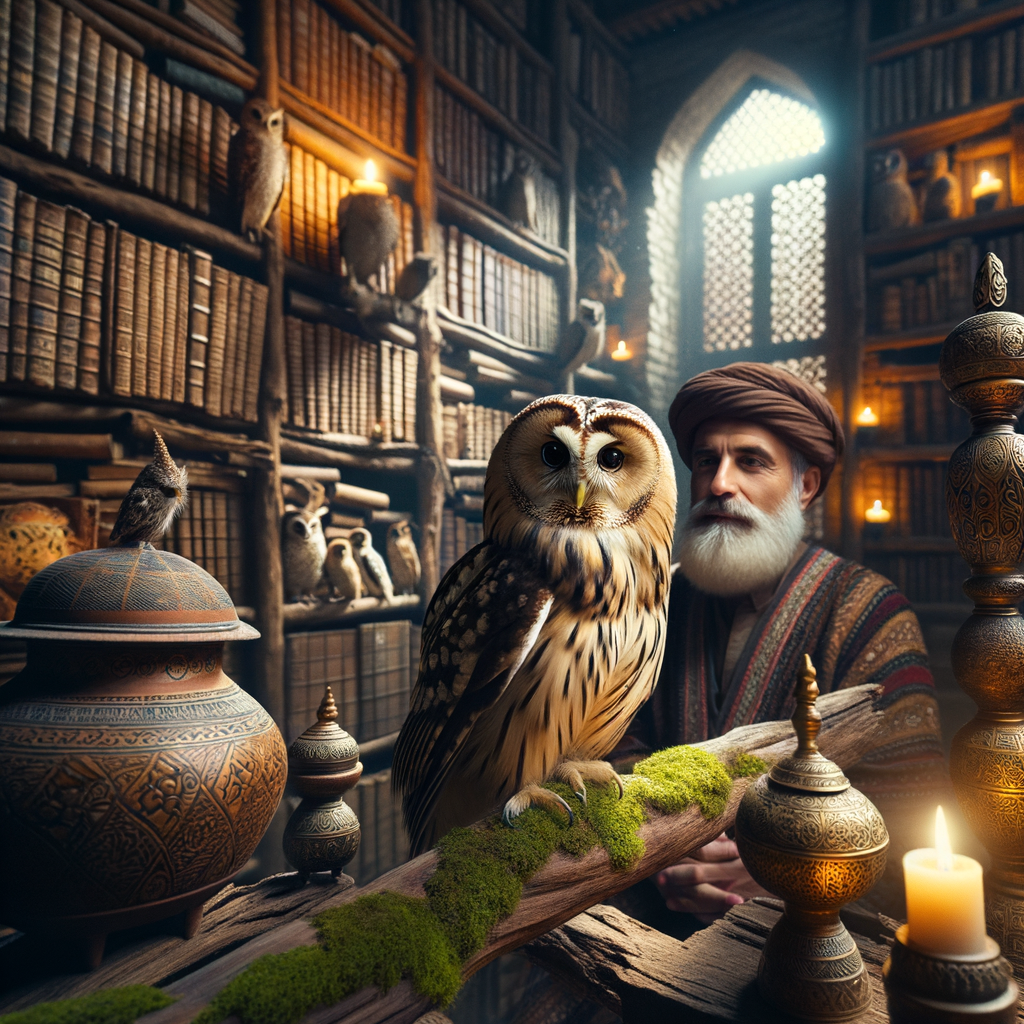
Owls and Humans Interaction: An Overview
-
- Introduction to human-owl relationship
Owls have always fascinated humans. These mysterious birds are known for their silent flight and nocturnal habits. People often see them as symbols of wisdom and mystery.
-
- Historical perspective of owls and human coexistence
Throughout history, owls have appeared in myths and stories. In ancient Greece, the owl was a symbol of Athena, the goddess of wisdom. In some cultures, owls were seen as protectors, while in others, they were thought to bring bad luck.
-
- Current state of human-owl interactions
Today, people still find owls fascinating. Bird watchers and nature lovers enjoy spotting them in the wild. Some even keep owls as pets, although this is not common. Conservation efforts are also in place to protect owl habitats and ensure their survival.
Owls in Human Culture
Symbolic Meaning of Owls
Owls have been a part of human culture for centuries. They appear in stories, myths, and even in our dreams. Let’s explore what owls symbolize.
- Wisdom and Knowledge: Owls are often seen as wise creatures. This is because they can see in the dark, which makes them seem like they know things others do not. In many cultures, owls are a symbol of learning and wisdom.
- Mystery and Magic: Their silent flight and nocturnal habits make them seem otherworldly. Some people believe owls have magical powers or can see into the future.
- Death and Transition: In some cultures, owls are seen as omens of death. They are thought to guide souls to the afterlife. This makes them symbols of transition and change.
| Symbol | Meaning |
|---|---|
| Wisdom and Knowledge | Seen as wise creatures, often linked to learning. |
| Mystery and Magic | Associated with magic and the unknown. |
| Death and Transition | Considered omens of death, guiding souls to the afterlife. |
Owls in Mythology and Folklore
-
Owls in Greek Mythology
Owls are linked to Athena, the goddess of wisdom. The owl is a symbol of knowledge and insight. Ancient Greeks believed that an owl flying over a battlefield meant victory.
Owls were also seen as protectors. They were thought to ward off evil spirits. This belief made them important in Greek culture.
-
Owls in Native American Folklore
Some tribes see owls as messengers. They believe owls bring important news, both good and bad.
For example, the Hopi tribe sees owls as protectors of the dead. They believe owls guide spirits to the afterlife. On the other hand, some tribes think owls are bad omens. They believe seeing an owl can mean danger or death.
-
Owls in Celtic Mythology
The owls are symbols of the underworld. They are seen as guides to the afterlife. The Celts believed owls could see what others could not.
Owls were also linked to the goddess of death and rebirth. They were seen as wise and powerful creatures. This made them important in Celtic culture.
Owls as Pets
-
Benefits and Challenges of Having Owls as Pets
They have beautiful feathers and big, round eyes. Some people think they make great pets. But owning an owl is not easy.
Benefits:
- Owls are unique and interesting.
- They can be very loyal to their owners.
- Owning an owl can be a great learning experience.
Challenges:
- Owls need a lot of space to fly.
- They have special diets, usually eating mice or other small animals.
- Owls can be noisy, especially at night.
- They require a lot of care and attention.
-
Legal Considerations
Before getting an owl, you must check the laws. In many places, it is illegal to own an owl without a special permit. These laws are in place to protect both the owls and people.
In the United States, for example, you need a permit from the U.S. Fish and Wildlife Service. This is because owls are protected under the Migratory Bird Treaty Act.
It is important to follow these laws to avoid fines and to ensure the owl is cared for properly.
-
Case Study: Owls as Pets in Japan
In Japan, owls have become popular pets. There are even owl cafes where people can interact with these birds. These cafes are places where people can enjoy a drink while spending time with owls.
However, there are concerns about the welfare of the owls in these cafes. Some experts worry that the owls do not get enough rest and may be stressed by constant human interaction.
Despite these concerns, owl cafes remain popular. They offer a unique experience for visitors and help raise awareness about these amazing birds.
Human Impact on Owl Habitats
Deforestation and Urbanization
-
Impact on owl populations
When trees are cut down, owls lose their homes. They need trees to nest and hunt. Urban areas also make it hard for owls to find food and safe places to live. This can lead to fewer owls in the wild.
-
Case study: Barn owls in rural England
Many barns and old buildings where they used to nest are being torn down. Farmland is also changing, which means fewer places for barn owls to hunt. A study showed that barn owl numbers have dropped because of these changes.
| Impact | Details |
|---|---|
| Loss of Habitat | Owls lose their nesting and hunting grounds when trees are cut down. |
| Urban Challenges | Urban areas make it hard for owls to find food and safe places to live. |
| Barn Owls in England | Old barns and farmlands are disappearing, leading to fewer barn owls. |
Climate Change
-
- Effects on owl migration patterns
One significant effect is on the migration patterns of owls. As temperatures rise, the habitats where owls live and hunt are changing. This forces them to move to new areas to find food and suitable living conditions. For example, some owls that used to stay in one place all year round are now migrating to cooler regions during the warmer months.
-
- Case study: Snowy owls and rising temperatures
These majestic birds usually live in the Arctic, where they hunt lemmings and other small animals. However, as the Arctic warms up, the number of lemmings is decreasing. This means snowy owls have to travel farther to find food.
According to a study by the National Audubon Society, snowy owls are now being seen in places they never visited before. For instance, more snowy owls are being spotted in the northern United States during winter. This is because they are searching for new hunting grounds as their traditional habitats become less suitable.
| Impact of Climate Change on Snowy Owls | Details |
|---|---|
| Habitat Loss | Arctic regions are warming, reducing the number of lemmings. |
| Increased Migration | Snowy owls are traveling farther to find food. |
| New Sightings | More snowy owls are being seen in the northern United States. |
Owls in Literature
-
Owls in Children’s Literature
they are often shown as wise and kind. For example, in the book “Winnie the Pooh” by A.A. Milne, there is an owl named Owl who is very smart and helps his friends.
-
Symbolic Use of Owls in Classic Literature
For instance, in William Shakespeare’s play “Macbeth”, an owl’s hoot is a sign of bad things to come. Owls are also seen as protectors of knowledge in many stories.
-
Case Study: The Role of Owls in Harry Potter Series
In the Harry Potter series by J.K. Rowling, owls play a big role. They deliver mail and are loyal pets to the wizards. Harry Potter’s owl, Hedwig, is a snowy owl who is very important to him. Owls in this series symbolize loyalty and magic.
Conclusion: The Future of Human-Owl Relationships
- Importance of conservation effortsMany owl species are at risk due to habitat loss and climate change. By supporting conservation programs, we can help ensure that owls continue to thrive in the wild. For example, organizations like the Audubon Society work tirelessly to protect bird habitats.
- Role of education in fostering respect for owlsSchools and communities can teach children about the importance of owls in our ecosystem. Programs that allow people to see owls up close can also help build a connection. When people understand owls better, they are more likely to protect them.
- Final thoughts on the fascinating connection between owls and humansOwls have been a part of human culture for centuries, appearing in myths, literature, and even as pets. As we move forward, it is important to continue learning about these amazing birds and to protect them for future generations. By working together, we can ensure that owls remain a part of our world.
| Key Point | Details |
|---|---|
| Conservation Efforts | Protecting habitats and supporting organizations like the Audubon Society. |
| Education | Teaching the importance of owls in schools and communities. |
| Human-Owl Connection | Understanding the cultural and ecological significance of owls. |






